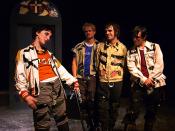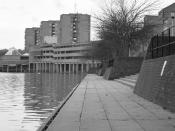Analysis of Humanism in Clockwork Orange
By: Removed For Privacy
02/02/2003
Human emotions, desires, and flaws are often subjects of focus in cinematography. From the basest desires of greed and hatred to the shining examples of purity and logic, man is painted in almost every manner imaginable. Stanley Kubrick, a master at depicting man's more twisted nature, offers a very dark view indeed, of what may lay in the future of humanity.
The morally derelict future of his Clockwork Orange is filled with roaming bands of young ruffians, who gorge themselves on drug-laced milk before nights filled with anguished screams of those whom they rape and brutalize. The movie surrounds these acts of violence with a wide-range of invented slang, taken from the book by Anthony Burgess, on which the movie is based, startling images of sexuality, a surprisingly sophisticated soundtrack, and conflicting views of freewill and society. The story unfolds through the life of Alex de Large, leader of a group of violent youths, whom he refers to by his Nadsat vocabulary as "droogs".
The language of the film is largely composed of an invented dialect called Nadsat, which is loosely based on bits of Russian and English slang. The fanciful speech helps to detach the viewer from exactly what is happening, although it is not quite as successful as it was in the book. Instead of "kicking an old man in the abdomen", Alex and his peers "kick a merzky ded in his brooko", and rather than offering some crude four-letter word for assaulting their female victims, they give them the "ole in-out-in-out", effectively reducing the act to it's most basic mechanical motions. This attempt to desensitize the viewer only heightens the awareness of the greater issues in the film, and draws attention to the state of...



Just a great essay.
This is a wicked essay. Only thing, you could have done more with talking about Kubrick's visuals, and how the 'future' looks very much like a 'souped up' version of 1971, but other than that, just great.
3 out of 3 people found this comment useful.